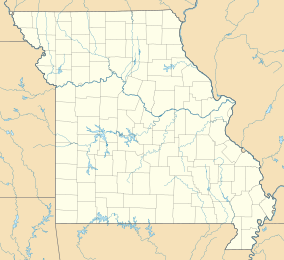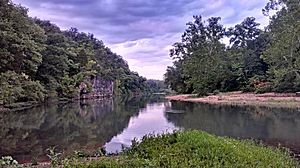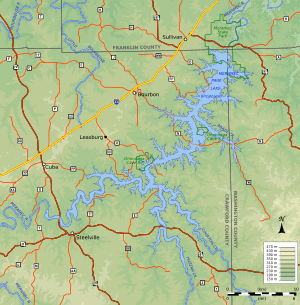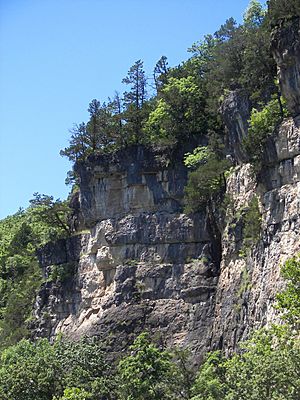Onondaga Cave State Park facts for kids
Quick facts for kids Onondaga Cave State Park |
|
|---|---|
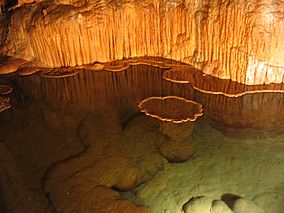
"Lily pad" formation in Onondaga Cave
|
|
| Location | Crawford, Missouri, United States |
| Area | 1,317.7 acres (5.333 km2) |
| Elevation | 732 ft (223 m) |
| Established | 1982 |
| Visitors | 286,763 (in 2017) |
| Governing body | Missouri Department of Natural Resources |
| Website | Onondaga Cave State Park |
| Designated: | 1980 |
Onondaga Cave State Park is a cool Missouri state park where you can explore amazing caves! It's located about 5 miles (8.0 km) southeast of Leasburg, right by the Meramec River. The park opened in 1982.
At the park, you can take tours inside the cave. You can also go camping, fishing, hiking, or have a picnic. It's a great place to visit!
Contents
Exploring Onondaga Cave's Past
Early Days and Discovery
In 1850, a family named Cresswell settled in this area. They built a mill on the Meramec River. But a big flood in 1881 destroyed their mill. William Henry Rollision Davis then bought the land. He built a new mill further from the river.
In 1886, a local person named Charles Christopher made an exciting discovery. He was looking at the spring that powered the new mill. He found a hidden cave behind it!
Christopher borrowed a boat and went into the cave. He explored the tunnels with two friends, John Eaton and Mitis Horine. They spent a whole day inside!
Inspired by their adventure, Christopher and Eaton bought the land above the cave. They wanted to turn it into a tourist spot. They called it the "Mammoth Cave of Missouri." This led to a long argument with Davis over who owned the cave.
Mining or Tours?
Back then, a special rock called "cave onyx" was popular. It was used in buildings. Many caves were being mined for this rock. Christopher and Eaton didn't have much money to develop their cave. They couldn't decide if they should mine it or open it for tours.
In 1897, they had the cave surveyed for mining. But they also gave tours to earn money. Arthur Hitch was one of the first tourists. He even published a book about the cave, using photos taken by Eaton.
New Owners and a New Name
In 1899, Davis passed away. His land was sold to a group from St. Louis. In 1902, Eaton sold his part of the cave. Christopher then sold his part too.
The new owners, George Bothe and Philip Franck, wanted to mine the cave. They tried some mining. But it was hard to get into the cave. Also, people weren't as interested in cave onyx anymore. So, mining wasn't very successful.
Instead, they decided to open the cave for tourists. This was just in time for the Louisiana Purchase Exposition in St. Louis in 1904.
The cave got its name, Onondaga, in 1904. Myrtle Land chose the name. It comes from an Iroquois tribe. "Onondaga" means "People of the Mountain."
Cave Wars and Competition
Over the years, the cave property changed hands many times. In 1930, a new problem arose. Dr. William Mook discovered that about half of Onondaga Cave was under his land!
Dr. Mook's team dug a tunnel into Onondaga Cave. They even put up a fence inside the cave! Their half of the cave became known as Missouri Caverns. Robert Lee Mook, Dr. Mook's brother, managed it.
In 1932, Missouri Caverns became the first electrically lit cave in the Ozarks region. Onondaga Cave now had two competitors: Missouri Caverns and another nearby cave called Cathedral Cave.
The court battles over the land continued. Onondaga Cave was also harder to reach from US 66. Missouri Caverns was closer and doing better.
A Political Debate Underground
In 1934, something funny happened. Senatorial candidate Harry S. Truman and his group planned to visit Missouri Caverns. At the same time, Republican Party members were touring Onondaga Cave.
The two groups met at the fence inside the cave. This was the fence that separated the two disputed properties. There, deep underground, the two political parties had a debate through the fence!
A Single Owner at Last
In 1935, the Missouri Supreme Court decided the land dispute. They ruled in favor of the Mooks and Missouri Caverns. But Bob Bradford, who owned Onondaga, didn't give up.
In 1937, Bradford built a motel at the cave's entrance. It was called the Cool Room. The cave's cool air kept the building at a nice temperature.
In 1938, Bradford dug a new entrance to Onondaga. Before this, tourists entered and left by boat. Now, they could enter by boat and walk out through the new entrance.
Missouri Caverns and Cathedral Cave closed during the World Wars. Tourism decreased, and legal problems continued. Onondaga's future was also uncertain after Bradford's death.
In 1945, Bradford's widow sold Onondaga to Barnard Hospital. For the first time, Onondaga Cave had only one owner! Charles Rice, a hospital director, took control. He also managed Cathedral Cave.
Finally, free from money and legal problems, the caves were improved. Electricity was brought to the area. The entire cave was wired for lights. Old tour paths were replaced with new trails, stairs, and bridges.
The Dill and Riley Era
In 1953, Lester B. Dill and Lyman Riley bought the property. They stopped the boat trips because of safety. But you can still see the old docks and a replica boat inside the cave today.
Dill was very experienced with caves. He had developed Meramec Caverns into a popular tourist spot. Riley was a retired teacher who had worked at both Meramec Caverns and Onondaga Cave.
This was a great time for the caves! Riley and Dill appeared on TV shows. Celebrities visited the caves. Stories were written, and they launched big advertising campaigns. Riley even became a minister and held church services and weddings inside the cave!
In 1967, Riley retired and sold his share to Dill. Onondaga was back to one owner. But in the 1970s, another big dispute began.
The Meramec River Dam Project
For many years, there were plans to build a dam on the Meramec River. This dam would help control floods. In 1967, Congress approved a plan for the Meramec Park Lake Project. This included a big dam and many smaller ones.
Many people were against the dam. Local farmers lost their land. People from St. Louis worried about the environment. They also loved the Meramec River for canoeing.
At first, Dill supported the dam. He thought he could run glass-bottom boats in the cave. But then a survey showed that the dam would flood 80% of Onondaga Cave! So, Dill joined the people who were against the dam.
Dill reopened Cathedral Cave during this time. He called it Missouri Caverns again. He added new trails and lights. A large rock formation inside was even renamed the Liberty Bell for the 1976 Bicentennial. But this cave closed after the dam project was defeated.
Citizens Stop the Dam
In 1978, people in 12 counties voted on the dam project. A large majority (64%) voted against building the dam. This was a huge victory for the citizens!
Congress listened to the voters. They decided to stop the project. This was the only time in the country that citizens stopped an Army Corps dam that was already being built!
Lester B. Dill passed away in 1980. He wanted the state to have the first chance to buy Onondaga. His family worked with the Nature Conservancy. The state legislature agreed to his wish.
Onondaga became a state park in 1982. It was also named a National Natural Landmark. This means it's a very special natural place.
In 1986, a big party was held. It celebrated 100 years since the cave was discovered. Today, Onondaga Cave is managed by the Missouri Department of Natural Resources. It is safe from land disputes and damage. A new visitor's center and nature museum were built in 1990.
Vilander Bluff Natural Area
The Vilander Bluff Natural Area is part of the state park. It's about 7 miles (11 km) northeast of the main park. This area has tall cliffs called bluffs.
These bluffs are home to unique plants and animals. You can find over 200 ancient red cedar trees here. Some of these trees are 200 to 500 years old!
The Meramec River flows through this area. On the opposite side of the bluffs, there's a rookery. A rookery is a place where birds gather to nest. This one has over 40 nests of the great blue heron!


